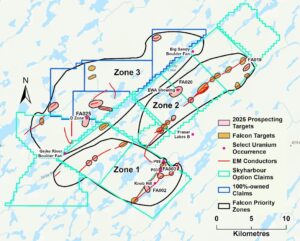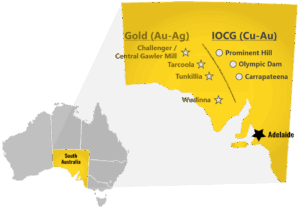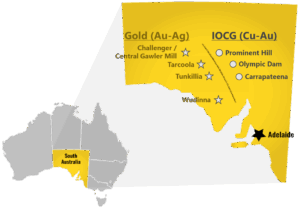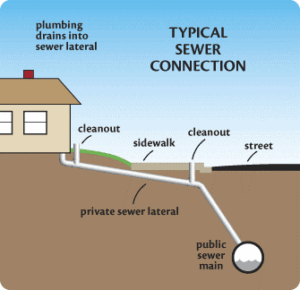VANCOUVER, BC / ACCESS Newswire / October 14, 2025 / North Shore Uranium Ltd. (TSXV:NSU) (“North Shore” or the “Company“) is pleased to announce the completion of a prospecting program on its Falcon Property (“Falcon” or the “Property“) located at the eastern margin of the Athabasca Basin in Saskatchewan.
The prospecting program was completed by Axiom Exploration Group and focused on eighteen priority targets that were identified by North Shore’s technical team. At each of these targets, the crew assessed the mapped surface expression of the interpreted electromagnetic (“EM“) conductor and surrounding area for outcrop and anomalous radioactivity. A Radiation Solutions (model RS-125) scintillometer that measures total radioactivity in counts per second (“cps“) was used to measure the radioactivity of outcrops and boulders and guide the selection of representative rock samples for laboratory analysis.
Significant radioactivity was confirmed in outcrop at targets FA020, up to 20,000 cps (the historic EWA Showing) and FA025, up to 27,000 cps (the historic D Zone Showing area) (Figure 1). In addition, several boulders with elevated radioactivity were discovered, including at targets FA019, close to 7,000 cps and FA033, up to 6,000 cps. Summaries of work done at several targets are presented below. Seventy-four rock samples were collected during the program and they have been submitted to the Saskatchewan Research Council (SRC) Geoanalytical Laboratory for uranium, associated metals and elements and Rare Earth Element analysis. Assay results are pending.
Brooke Clements, President and CEO of North Shore stated: “We think that Falcon has all the right ingredients to yield a signficant new uranium discovery. It is in the Athabasca Basin region, host to Canada’s only two uranium mines and three development-stage projects. Uranium mineralization has been confirmed on the property, and the past-producing Key Lake Uranium Mine and active Key Lake Mill is nearby. We have identified a number of high priority, drill-ready targets along portions of a prominent EM conductor system that have seen no historic drilling.“
PRIORITY TARGETS BY ZONE
Three priority areas have been established at Falcon, Zones 1, 2 and 3. Within these three areas, 36 uranium targets have been identified (Figure 1). The targets are associated with EM conductor anomalies and have been selected based on the analysis and interpretation of multiple geophysical and geologic datasets.
ZONE 1
Located within Zone 1, the South Priority Area includes the three kilometre (“km“) long NNE-trending conductor/structural zone where uranium was discovered by North Shore in 2024 in drill holes P03 and P08 (Figure 2). As reported on May 16, 2024, at P03, a zone from 196.6 to 209.0 metres (“m“) included an interpreted brittle fault zone with graphite-rich fault gouge and two samples that returned 345 and 378 ppm U3O8. At P08, a 4.7 m interval between 42.3 and 47.0 m returned 316 ppm U3O8,including one sample with 572 ppm U3O8. Also at P08, a brittle, altered pegmatitic and graphitic fault zone with elevated U3O8 values up to 50 ppm was intersected from 102.3 to 105.5 m, the modelled depth of the EM conductor.
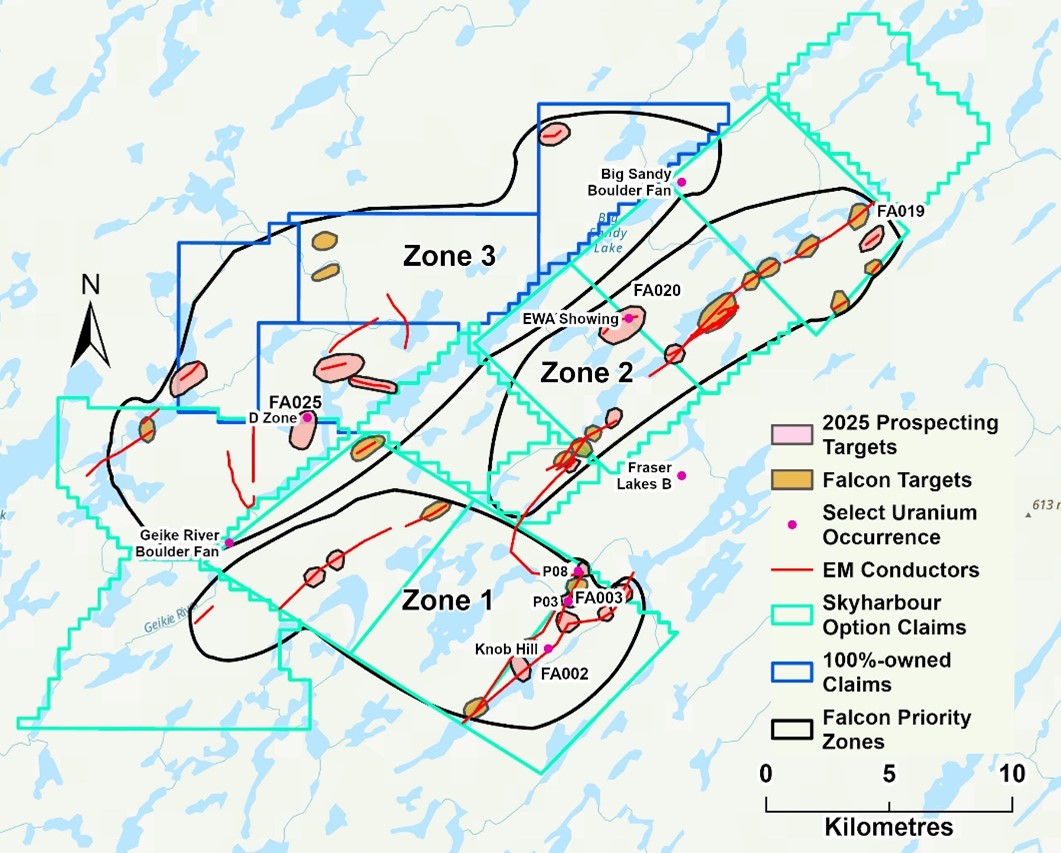
EM conductors from Saskatchewan database and North Shore interpretation, targets from North Shore interpretation
Figure 1: Property map showing Falcon’s 3 exploration priority zones, priority exploration targets and the targets assessed during the prospecting program in August.
Target FA003 is at the south end of the potential mineralized trend defined by P03 and P08. At FA003, the EM conductor system and an associated magnetic low are disrupted and the system splits, with one arm going to the northeast, the other to the north. In addition, there is a gravity low anomaly which can be an expression of alteration that could be associated with uranium mineralization (Figure 3). The prospecting crew determined that most of the traces of the interpreted EM conductors are covered by muskeg. At the south end of the target zone, weakly radioactive pegmatitic and granitic boulders are present and are associated with an airborne radiometric uranium anomaly.
At target FA005, the conductor is intersected by an interpreted fault. Southwest of this, in an interpreted down-ice direction from the target, the prospecting team identified radioactive boulders within a boulder field. Metasedimentary and granitic boulders had radioactivity readings from 500-3,000 cps (Figure 2). At target FA033, where hole P03 was drilled by North Shore in 2024, a pegmatite boulder that was discovered registered 5,000-6,000 cps.
Approximately two km south of FA003 target FA002 is defined by two strong parallel EM conductors and a parallel magnetic low trend, and it is intersected by an interpreted northwest-trending fault. The conductor/fault intersections are under a lake, but a hill just southeast of the target showed a strong uranium anomaly defined by the 2022 airborne radiometric survey. The crew found several mica-rich stringers of radioactive pegmatite in outcrop in this area.
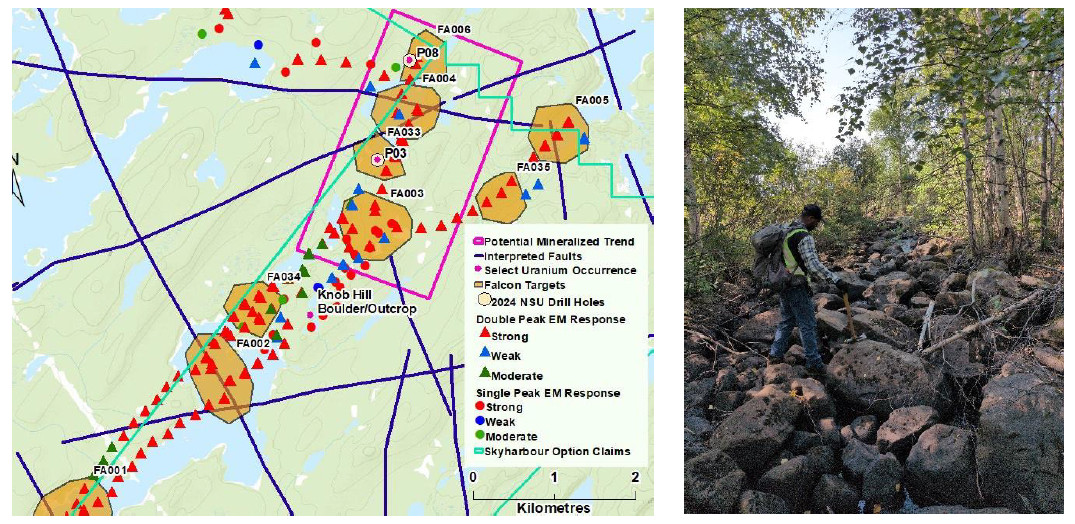
Figure 2. South Priority Area (Zone 1) targets, EM and structural interpretation by Condor North Consulting LLC (“Condor“). Photo shows radioactive boulder field southwest (down-ice) of FA005.
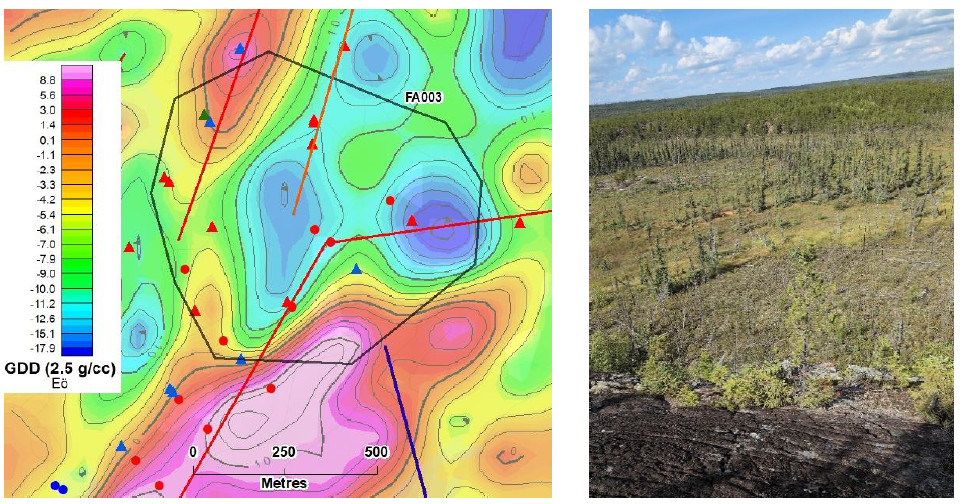
Vertical gravity gradient (GDD) data processing by Condor, 2.5 g/cm3 density used in terrain correction, data presented in Eötvös (Eö). Structural and EM interpretation by Condor; single- and double-peaked responses picked from airborne survey profiles.
Figure 3. Target FA003 with gravity background, Zone 1. Photo taken near the conductor split looking NW from a weakly foliated to massive metapelite outcrop to the interpreted conductor surface projection in a swampy low-lying area.
ZONE 2
Target FA020, in the central portion of Zone 2 includes the EWA showing. It is centered on a short, isolated, strong northeast-trending, 1.5 km long EM conductor (Figures 1 and 4). Up to 0.492% U3O8 and 1,300 ppm lead was encountered in outcrop grab samples within a 10-20 m wide northeast-trending sheared pelitic unit with granitic inliers ([SMDI] 5038). In 2008, JNR Resources drilled seven holes from six sites associated with the EWA showing at the eastern end of the EM conductor. Anomalous uranium, boron, lead, and molybdenum were encountered in structurally disrupted pegmatites; the best result was 0.235% U3O8 over 0.5 m (within a 3.5 m interval of 0.113% U3O8) in hole WYL-08-501 (Sask. Mineral Assessment File 74H02-0045).
The prospecting team located the showing, a radioactive 10 m by 10 m granitic gneiss outcrop characterized by folding, shearing and micro-fracturing with local hematite and clay alteration with readings up to 20,000 cps. North Shore plans to further evaluate the 1.2 km-long conductor system associated with EWA to determine if more drilling may be warranted at different sites along the conductor system or to expand on previous drilling targets.
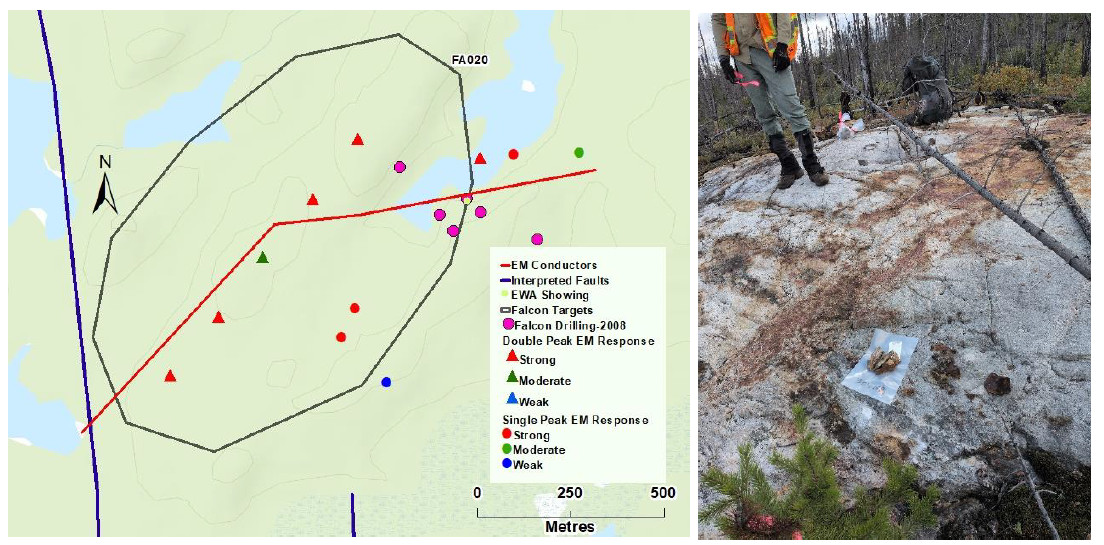
EM conductor trace and uranium showing from Saskatchewan database. Structural and EM interpretation by Condor; single- and double-peaked responses picked from airborne survey profiles.
Figure 4. Target FA020/EWA Showing area, Zone 2. Photo is of highly radioactive outcrop.
Target FA019, which is located at the eastern edge of the Property, is a 700 m long, strong EM conductor that is parallel to, and one km south of the main EM conductor trend at Falcon (Figures 1 and 5). The conductor is terminated at its western end by an interpreted prominent north-south-trending fault zone. The prospecting crew found one radioactive boulder that registered close to 7,000 cps on the scintillometer at this location. The granitic gneiss boulder had a 10 cm wide quartz vein with a mica-rich contact that displayed hematite alteration. The interpreted trace of the conductor roughly corresponds with an east-west-trending boulder train within a stream drainage.
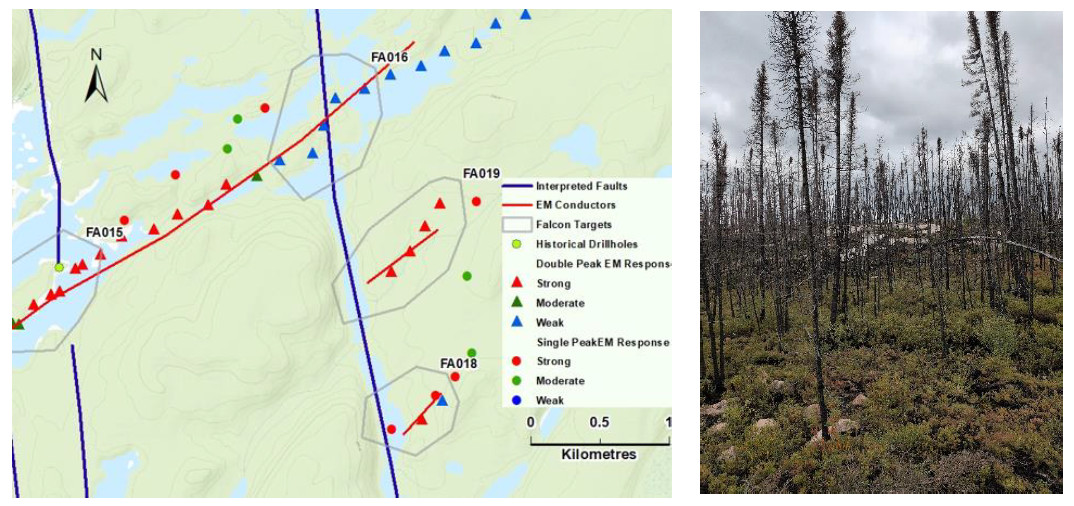
EM conductor trace from Saskatchewan database. Structural and EM interpretation by Condor; single- and double-peaked responses picked from airborne survey profiles.
Figure 5. Target FA019, photo shows interpreted conductor in foreground and outcrop in background.
ZONE 3
Target FA025 includes the D Zone showing and a complex and isolated approximately one km long anomalous EM response defined by variable conductor strength that is, in part, coincident with a magnetic low feature (Figure 6). The D Zone showing was discovered in 1978 by field inspection of an anomaly identified from an EM survey flown by AGIP in 1978 that was interpreted to be a graphitic conductor. The D Zone showing and associated work programs are described in [SMDI 2455] and Saskatchewan Assessment files 74A14-0034 and 74A14-0035. The showing is described as a uraniferous vein with associated molybdenite and pyrite; a breccia zone was also sampled. The best sample returned 1.26% U and 0.8% Mo. AGIP reported four additional samples from the D Zone area with greater than 1000 ppm (.1%) U. In 1978, a lake sediment sample collected from a small lake 800 m northwest of the D Showing returned 38 ppm U (Figure 6). In 1980 three shallow holes with a cumulative depth of 350 m were drilled by AGIP. One metre sample intervals in zones of anomalous radioactivity in core from two drill holes were analyzed. One of the intervals returned 54 ppm U, the other 36 ppm. Minor hematite, chlorite and kaolinite alteration was encountered throughout the core.
In 2022, a North Shore crew identified elevated radioactivity in one outcrop area coincident with the mapped D Zone location, but the vein was not located. The 2025 prospecting crew traversed much of the target area but was unable to locate the uriniferous vein, it is likely covered by vegetation. The crew did locate two radioactive pegmatite dykes approximately 700 m apart (Figure 6). At the first site, located approximately 500 m north of the target zone and just west of the powerline along the lakeshore, the crew located a pegmatite dyke that was discovered by AGIP in 1978. The 10 m wide, 30 m long coarse-grained dyke exhibited local hematite alteration and background radioactivity readings of 10,000 to 27,000 cps. The eastern coarse-grained pegmatite dyke was approximately 5 m wide and 20 m long, background radioactivity levels of the outcrop ranged from 3,500 to 5,000 cps. The Company intends to integrate the EM conductor models at FA025 with shallow historic drilling and geologic mapping data and consider the drilling of additional and deeper holes. Overall, the isolated EM conductor on land that is coincident with a magnetic low response and proximal to a known uranium showing is a highly prospective target.
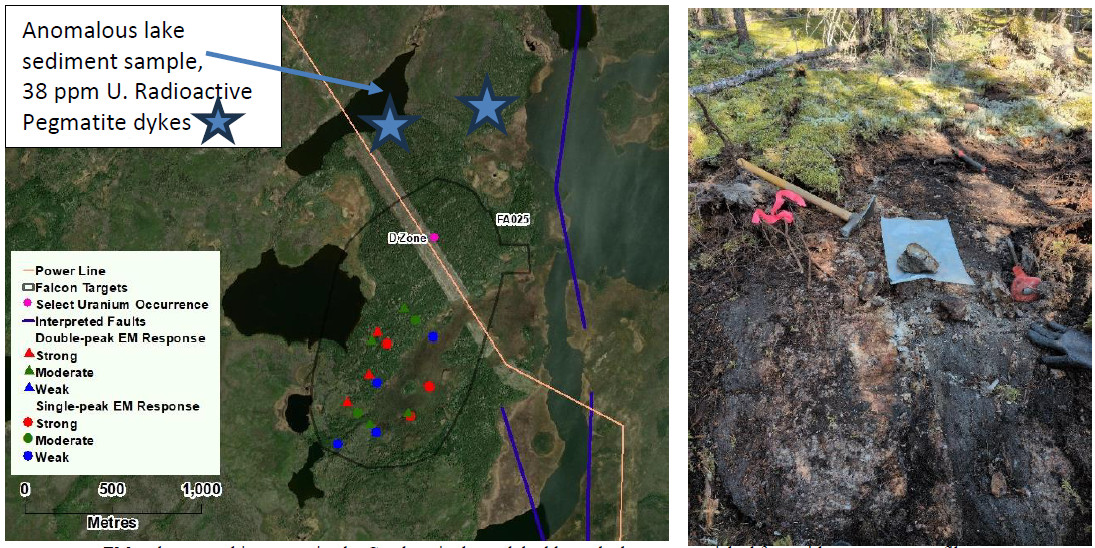
EM and structural interpretation by Condor; single- and double-peaked responses picked from airborne survey profiles.
Figure 6. Summary of FA025 Area, photo is of the eastern pegmatite dyke which had background readings of 3,500 to 4,000 cps.
NEXT STEPS
In an effort to make a significant new uranium discovery, North Shore is integrating information from the prospecting program with the interpretation of the EM conductors to further evaluate and prioritize targets shown in Figure 1 for potential future drilling programs.
FALCON BACKGROUND INFORMATION
In May 16, 2024, September 17, 2024, October 10, 2024, November 13, 2024, February 27, 2025 and May 6, 2025 news releases, the Company summarized its exploration efforts at Falcon. Historical technical information at Falcon is provided in North Shore’s 2023 technical report link. The primary exploration focus is to prioritize targets in areas that have not seen drilling. Prior to 2024, approximately 50 exploration holes had been drilled at Falcon, with 28 of those completed in 2008. All the 2008 drilling was done along prominent EM conductor systems in Zone 2. Until North Shore’s 2024 drill program, no drilling had been completed along the southern portion of that conductor system.
Falcon consists of 15 mineral claims totaling 55,503 hectares; four of the claims comprising 12,791 hectares are 100 percent-owned by the Company and the remaining 11 claims are subject to an option agreement with Skyharbour Resources Ltd. Under the terms of the option agreement, North Shore has the option to earn an 80 percent interest in the 11 claims by completing certain payments, exploration work and other commitments by October 2026. Falcon is located 30 km east of the active Key Lake uranium mill and former mine. Between 1983 and 2002, the mine produced a total of 209.9 million pounds of U3O8 at an average grade of over 2.0%1.
ABOUT NORTH SHORE
The nuclear power industry is in growth mode as more nuclear power will be required to meet the world’s ambitious CO2 emission-reduction goals and the needs of new power-intensive technologies like AI. In this environment, new discoveries of economic uranium deposits will be very valuable, especially in established uranium-producing jurisdictions like Saskatchewan and New Mexico. North Shore is well-positioned to become a major force in exploration for economic uranium deposits. The Company is working to achieve this goal by exploring Rio Puerco in the Grants Uranium District of New Mexico and its Falcon and West Bear properties at the eastern margin of the Athabasca Basin in Saskatchewan. Technical information on the Rio Puerco project is available in North Shore’s June 24, 2025, news release. In addition, the Company continues to evaluate quality opportunities in the United States and Canada to complement its portfolio of uranium properties.
QUALIFIED PERSONS STATEMENT
Mr. Brooke Clements, MSc, P.Geol., a Qualified Person as defined by National Instrument 43-101 – Standards of Disclosure for Mineral Projects and the President and CEO of North Shore, has reviewed and approved the scientific and technical disclosure in this press release. Troy Marfleet, P. Geo. of Axiom Exploration Group, who is also a Qualified Person, and a co-author of North Shore’s 2023 Falcon technical report, supervised the Axiom field crew and has verified the prospecting data disclosed in this press release.
Readers are cautioned that radioactivity levels in rocks reported in this press release measured in cps by the hand-held RS-125 scintillometer are not uniformly or directly related to the actual uranium content of the rock samples measured and should be treated only as a preliminary measure of the presence of radioactive minerals. The 74 rock samples that were collected during the prospecting program will be analyzed for their uranium content.
ON BEHALF OF THE BOARD
Brooke Clements,
President, Chief Executive Officer and Director
For further information:
Please contact: Brooke Clements, President, Chief Executive Officer and Director
Telephone: 604.536.2711
Email: b.clements@northshoreuranium.com
www.northshoreuranium.com
Neither the TSX Venture Exchange nor its Regulation Services Provider (as that term is defined in the policies of the TSX Venture Exchange) accepts responsibility for the adequacy or accuracy of this release.
Forward-Looking Statements
This news release contains forward-looking statements relating specifically to the Falcon Property prospecting program and the Company’s broader exploration strategy. Forward-looking statements in this release include: the pending laboratory results for the 74 rock samples collected during the Falcon prospecting program; the Company’s plans to further evaluate and prioritize targets for potential future drilling programs based on the integration of prospecting results and EM conductor interpretation; the intention to model EM conductors at the FA025 target and integrate these models with historic drilling and geologic mapping, which may lead to additional or deeper drill holes; the expectation that Falcon has the right ingredients to yield a significant new uranium discovery, including the identification of high priority, drill-ready targets along a portion of a prominent EM conductor system that have seen no historic drilling; North Shore’s belief that it is well-positioned to become a major force in exploration for economic uranium deposits; the Company’s ongoing work to achieve this goal by exploring Rio Puerco in New Mexico and its Falcon and West Bear properties in Saskatchewan; and the Company’s continued evaluation of quality opportunities in the United States and Canada to complement its portfolio of uranium properties. These statements are subject to specific risks and uncertainties, including: the possibility that laboratory assay results may not confirm the elevated radioactivity measured in the field; uncertainties in the interpretation of geophysical data, including EM conductors and gravity anomalies, which may not accurately reflect subsurface mineralization; the risk that identified targets may not yield economically viable mineral deposits upon further exploration or drilling; the potential for delays or changes in exploration plans due to environmental conditions, permitting requirements, or logistical challenges in accessing certain areas of the Falcon Property; and the reliance on historical data and previous exploration results, which may have limitations or uncertainties that affect current interpretations. Forward-looking statements are frequently characterized by words such as “plan”, “project”, “appear”, “interpret”, “coincident”, “potential”, “confirm”, “suggest”, “evaluate”, “encourage”, “likely”, “anomaly”, “continuous” and variations of these words as well as other similar words or statements that certain events or conditions “could”, “may”, “should”, “would” or “will” occur. These statements are subject to various risks and uncertainties that may cause actual results to differ materially from those anticipated or implied, including, but not limited to: the speculative nature of mineral exploration and development projects; the ability to obtain necessary permits and approvals; changes in project plans and parameters; variations in mineral grades and recovery rates; accidents, labour disputes and other risks of the mining industry; the availability of funding on terms acceptable to the Company; delays in obtaining governmental approvals or financing; fluctuations in metal prices; and other factors described in the Company’s public disclosure documents. There may be other factors that cause actual results, performance, or achievements to differ materially from those anticipated or implied by the forward-looking statements. Any forward-looking statement speaks only as of the date on which it is made and, except as may be required by applicable securities laws, the Company disclaims any intent or obligation to update any forward-looking statement, whether as a result of new information, future events, or results or otherwise. Forward-looking statements are not guarantees of future performance and undue reliance should not be put on such statements due to the inherent uncertainty therein. Any forward-looking statements contained in this news release are expressly qualified in their entirety by this cautionary statement.
1Source: Government of Saskatchewan – Mineral Deposit Query (https://mineraldeposits.saskatchewan.ca/Home/Viewdetails/1130). There is no guarantee that a uranium deposit similar to Key Lake will be discovered on the Falcon Property.
SOURCE: North Shore Uranium Ltd.
View the original press release on ACCESS Newswire








